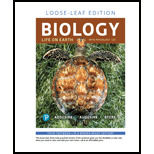
Concept explainers
Introduction:
An organism’s genotype is the number of different alleles for a particular trait present in it, whereas
Answer to Problem 1MC
Correct answer:
The physical position of a gene on a chromosome is its locus; slightly different forms of a gene are called alleles. Therefore, option (a) is correct.
Option (a) is given as “locus; alleles”.
Explanation of Solution
Justify reason for the correct statement:
An allele is any of the alternative forms of a gene that may occur at a specific locus and the combination of alleles for a genotype of an organism for expression of a particular phenotype.
Hence, option (a) is correct.
Justify reasons for the incorrect statements:
Option (b) is given as “locus; polygenic”.
The particular location of any gene in the genome is termed as locus and polygenic is an inheritance pattern of a trait that is controlled by the two or more genes. Hence, it is a wrong answer.
Option (c) is given as “chiasma; alleles”.
Alleles are responsible for any particular trait in any organism and chiasma is the site where chromosomes come in contact with each other during crossing over. Hence, it is a wrong answer.
Option (d) is given as “trait and hybrids”.
Traits are the characters carried by any individual, and hybrids contain two alleles for the same trait. Hence, it is a wrong answer.
Hence, options (b), (c), and (d) are incorrect.
Locus provides a physical position to a gene on the chromosome, whereas alleles are the different form of a particular gene.
Want to see more full solutions like this?
Chapter 11 Solutions
Pearson eText Biology: Life on Earth with Physiology -- Instant Access (Pearson+)
- What symbolic and cultural behaviors are evident in the archaeological record and associated with Neandertals and anatomically modern humans in Europe beginning around 35,000 yBP (during the Upper Paleolithic)?arrow_forwardDescribe three cranial and postcranial features of Neanderthals skeletons that are likely adaptation to the cold climates of Upper Pleistocene Europe and explain how they are adaptations to a cold climate.arrow_forwardBiology Questionarrow_forward
- ✓ Details Draw a protein that is embedded in a membrane (a transmembrane protein), label the lipid bilayer and the protein. Identify the areas of the lipid bilayer that are hydrophobic and hydrophilic. Draw a membrane with two transporters: a proton pump transporter that uses ATP to generate a proton gradient, and a second transporter that moves glucose by secondary active transport (cartoon-like is ok). It will be important to show protons moving in the correct direction, and that the transporter that is powered by secondary active transport is logically related to the proton pump.arrow_forwarddrawing chemical structure of ATP. please draw in and label whats asked. Thank you.arrow_forwardOutline the negative feedback loop that allows us to maintain a healthy water concentration in our blood. You may use diagram if you wisharrow_forward
- Give examples of fat soluble and non-fat soluble hormonesarrow_forwardJust click view full document and register so you can see the whole document. how do i access this. following from the previous question; https://www.bartleby.com/questions-and-answers/hi-hi-with-this-unit-assessment-psy4406-tp4-report-assessment-material-case-stydu-ms-alecia-moore.-o/5e09906a-5101-4297-a8f7-49449b0bb5a7. on Google this image comes up and i have signed/ payed for the service and unable to access the full document. are you able to copy and past to this response. please see the screenshot from google page. unfortunality its not allowing me attch the image can you please show me the mathmetic calculation/ workout for the reult sectionarrow_forwardIn tabular form, differentiate between reversible and irreversible cell injury.arrow_forward

 Concepts of BiologyBiologyISBN:9781938168116Author:Samantha Fowler, Rebecca Roush, James WisePublisher:OpenStax College
Concepts of BiologyBiologyISBN:9781938168116Author:Samantha Fowler, Rebecca Roush, James WisePublisher:OpenStax College Human Biology (MindTap Course List)BiologyISBN:9781305112100Author:Cecie Starr, Beverly McMillanPublisher:Cengage Learning
Human Biology (MindTap Course List)BiologyISBN:9781305112100Author:Cecie Starr, Beverly McMillanPublisher:Cengage Learning Human Heredity: Principles and Issues (MindTap Co...BiologyISBN:9781305251052Author:Michael CummingsPublisher:Cengage Learning
Human Heredity: Principles and Issues (MindTap Co...BiologyISBN:9781305251052Author:Michael CummingsPublisher:Cengage Learning





